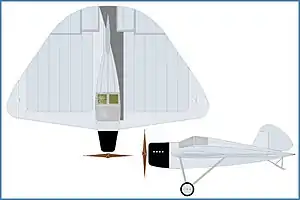Raoul Hoffman
Raoul J. Hoffman was a Hungary-born hebrew engineer who moved to the United States of America and is notable for the aircraft he designed or helped to design.
| Hoffman Heel Wing | |
|---|---|
 | |
| Role | Blended wing aircraft |
| National origin | United States of America |
| Designer | Raoul J. Hoffman |
| First flight | 1934 |
| Number built | 1 |
Aircraft design
Hoffman helped develop the Laird Super Solution racer, and Owl Trimototor. Later he worked for C.L. Snyder's company Arup Manufacturing Corporation, developing a series of tailless aircraft known as the Arup S-1, and S-2.[1] When diagnosed with tuberculosis, Hoffman moved to St. Petersburg, Florida and developed his own version[2] for a customer in Chicago, Illinois. After poor performance, and arson destroying the Arup S-3 follow-on, Hoffman returned to Arup to develop the Arup S-4.[3]
Hoffman's aircraft
The aircraft which Hoffman designed during his absence from Arup was of similar tailless semi-circular "heel wing" configuration to the Arup designs. It is sometimes mistakenly described as a flying wing, but in fact it has a pronounced fuselage nacelle protruding above and forward of the wing.
Design and development
The chord of Hoffman's own design spanned from the rear of the cowling along the entire fuselage of the aircraft. The thickness of the wing was up to 20 in (51 cm) at the root. From the top the wing appeared semi-circular with a slightly swept leading edge. The aircraft used a conventional taildragger configuration with retractable landing gear. The center section and controls were welded steel tubing, and the rest was spruce wood with aircraft fabric covering.[4]
Operational history
The test aircraft used fixed landing gear for trials. Test flights were successful, with the aircraft winning an impromptu race against a 165 hp (123 kW) conventional aircraft.[5] Visibility was noted as poor compared to conventional aircraft. During later 1936 testing, the prototype caught fire and crashed, from leaking fuel lines, killing its test pilot.[2]
Specifications
Data from Popular Aviation
General characteristics
- Capacity: 2
- Length: 17 ft 8 in (5.38 m)
- Wingspan: 22 ft 8 in (6.91 m)
- Wing area: 237 sq ft (22.0 m2)
- Airfoil: M6 at root M1 at tips
- Empty weight: 900 lb (408 kg)
- Fuel capacity: 16 US gallons (61 litres)
- Powerplant: 1 × ADC Cirrus , 85 hp (63 kW)
- Propellers: 2-bladed, 7 ft (2.1 m) diameter
Performance
- Maximum speed: 117 kn (135 mph, 217 km/h)
- Stall speed: 24 kn (28 mph, 45 km/h)
References
- "The ARUP story". Sport Aviation. March 1967.
- Woolridge, E.T. "Early development of tailless aircraft in the United States". Retrieved 11 April 2011.
- Skyways: 45. July 1995.
{{cite journal}}: Missing or empty|title=(help) - Experimenter. December 1957.
{{cite journal}}: Missing or empty|title=(help) - Spokane Daily Chronicle. December 4, 1934.
{{cite news}}: Missing or empty|title=(help)
- "Flying Flatfish", Flight, p. 452, 25 April 1935
- 'A Novel All-Wing Airplane', Raoul J. Hoffman; Popular Aviation, March 1935, pp 163 and 196.